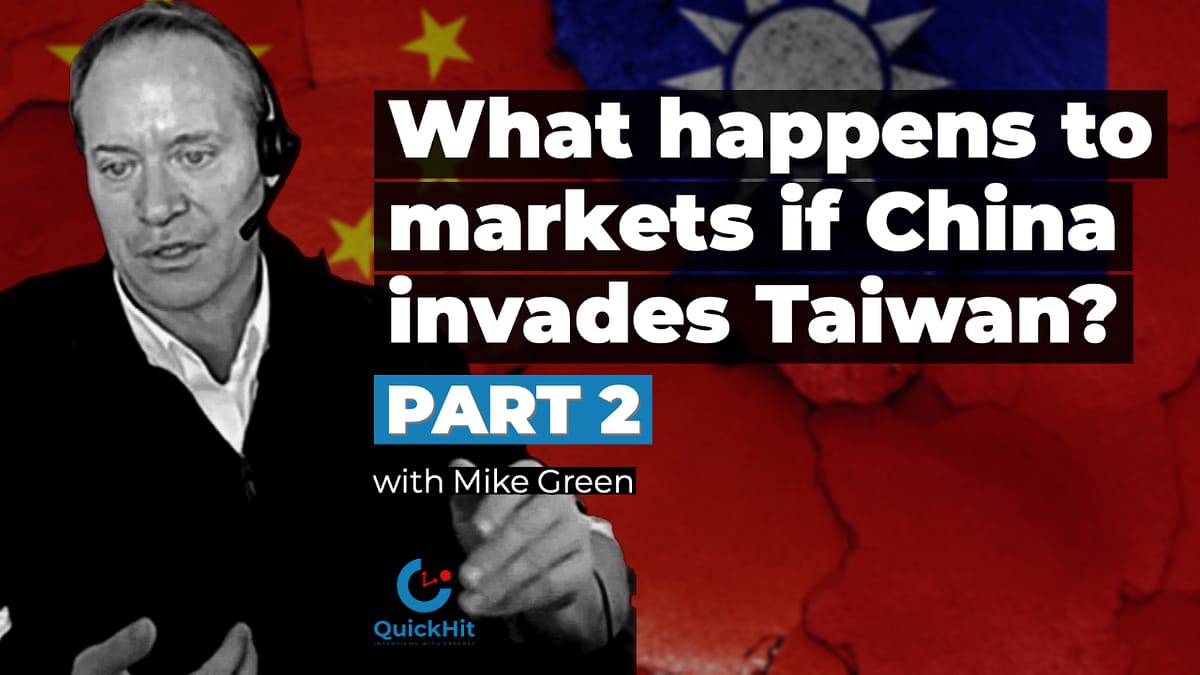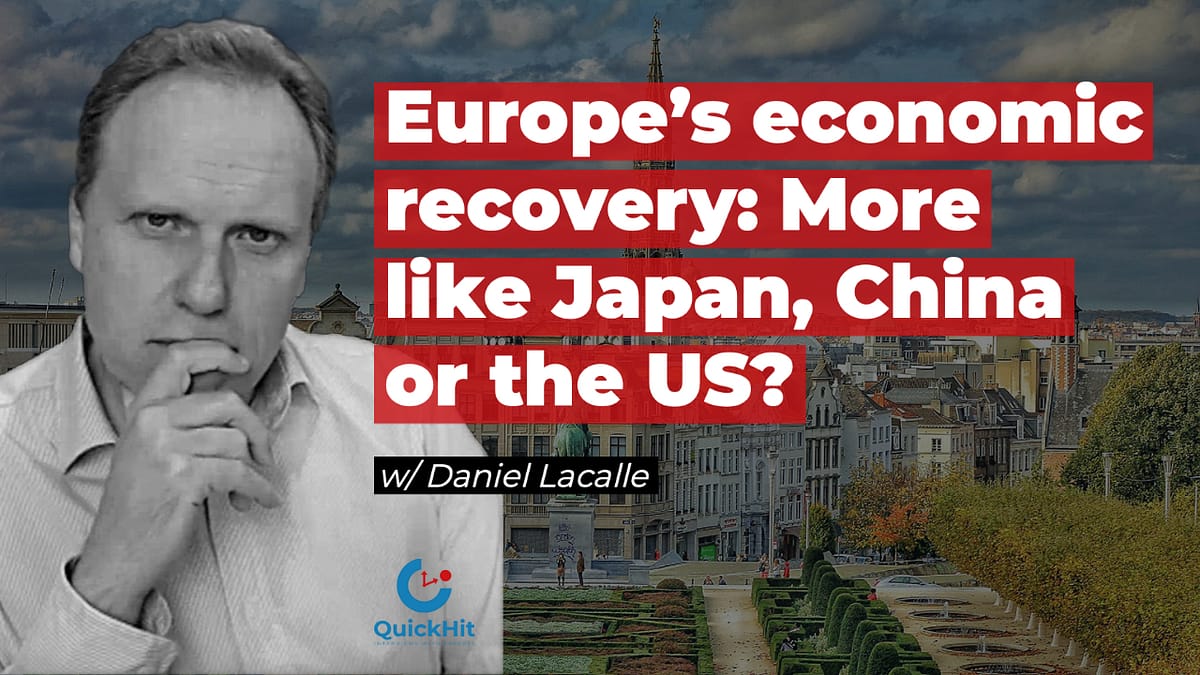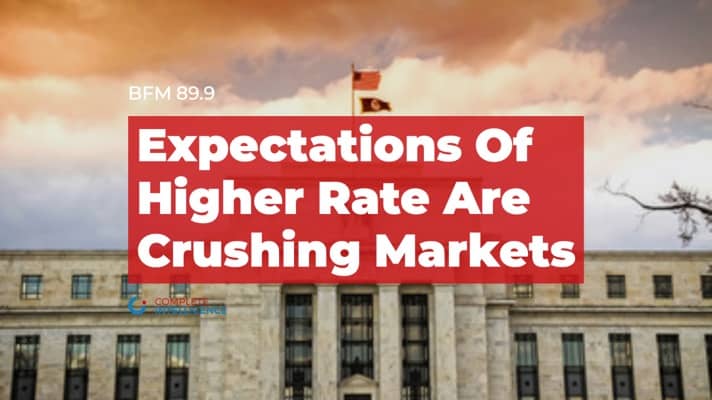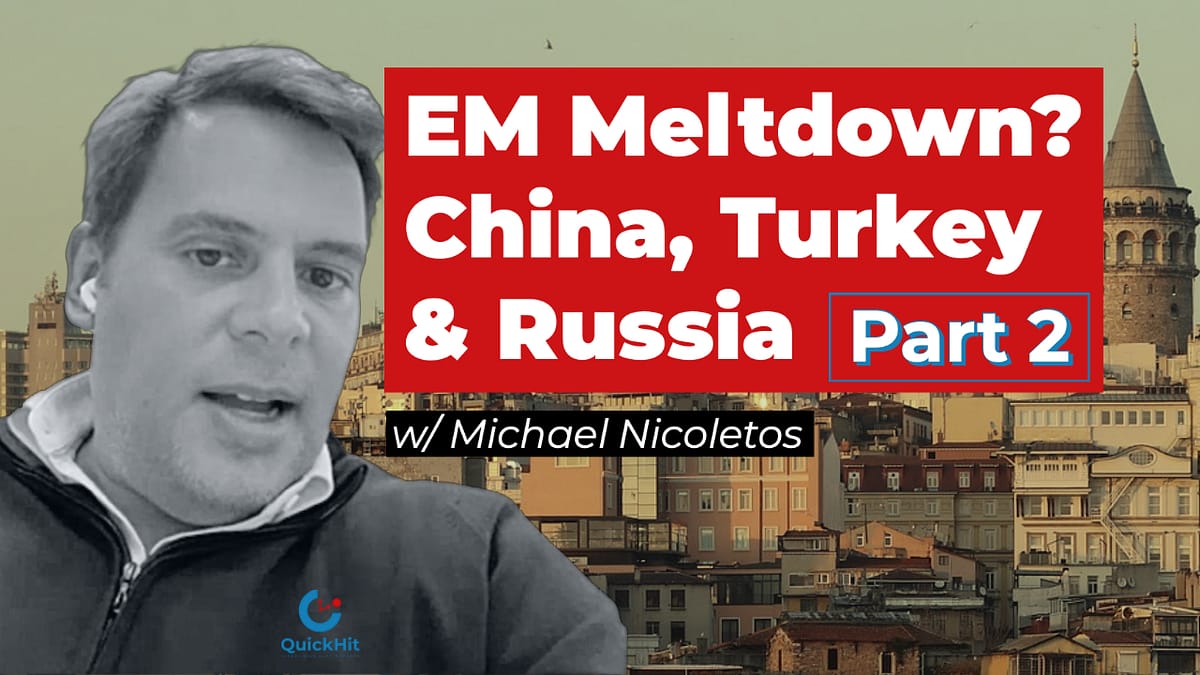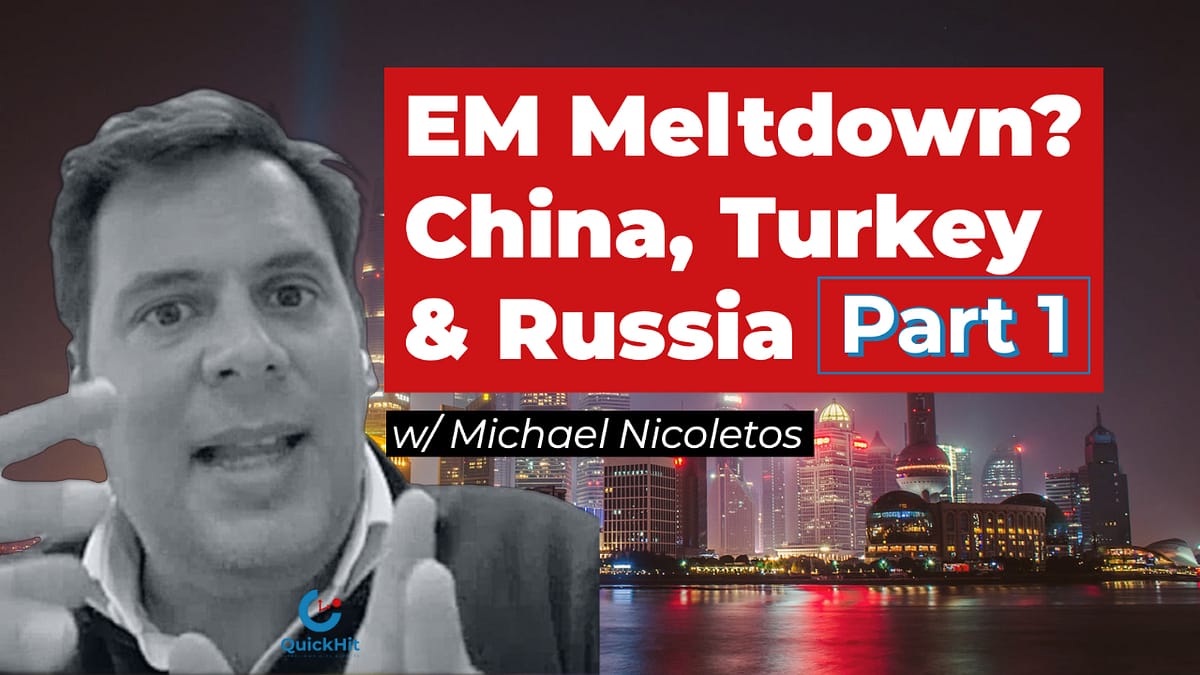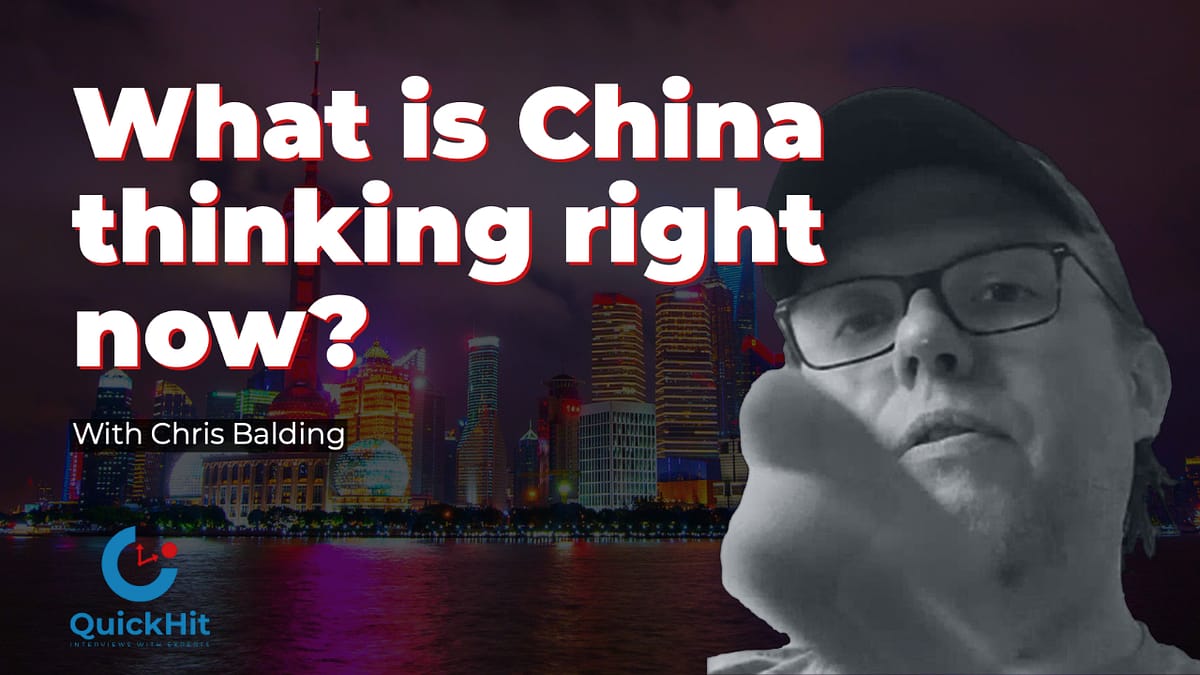Get 94.7% accuracy on your markets forecasts with CI Futures. Subscribe for only $50/mo for a limited-time only: http://completeintel.com/2022Promo
In this second part, Mike Green explains what will happen to Europe if China invades Taiwan. Will the region be a mere audience? Will it be affected or not, and if so, how? How about the Euro — will it rise or fall with the invasion? Also, what will happen to China’s labor in that case, and will Chinese companies continue to go public in the West?
You can watch Part 1 of the discussion here.
📊 Forward-looking companies become more profitable with Complete Intelligence. The only fully automated and globally integrated AI platform for smarter cost and revenue planning. Book a demo here.
📈 Check out the CI Futures platform to forecast currencies, commodities, and equity indices
This QuickHit episode was recorded on December 2, 2021.
The views and opinions expressed in this What happens to markets if China invades Taiwan? Part 2 Quickhit episode are those of the guest and do not necessarily reflect the official policy or position of Complete Intelligence. Any contents provided by our guest are of their opinion and are not intended to malign any political party, religion, ethnic group, club, organization, company, individual or anyone or anything.
Show Notes
TN: So we have a lot of risk in, say, Northeast Asian markets. We have a lot of risk to the electronics supply chain. I know that this may seem like a secondary consideration. Maybe it’s not.
What about Europe? Does Europe just kind of stand by and watch this happen, or are they any less, say, risky than any place else? Are they insulated? Somehow?
I want to thank everyone for joining us. And please, when you have a minute, please follow us on YouTube. We need those follows so that we can get to the right number to reach more people.
MG: No, Europe exists, I would argue, as basically two separate components. You have a massive export engine in the form of Germany, whose core business is dealing with China and to a lesser extent, the rest of the world. And then you have the rest of Europe, which effectively runs a massive trade deficit with Germany. I’m sorry. Germany is uniquely vulnerable in the same way that the corporate sector is vulnerable in the United States. That supply chain disruption basically means things go away.
They are also very vulnerable because of the Russian dynamic, as we discussed. In many ways, if I look at what’s happened to Germany over the past decade, their actions on climate change and moving away from nuclear, away from coal into solar, et cetera, has left them extraordinarily dependent upon Russian natural gas supplies. It’s shocking to me that they’ve allowed themselves to get into that place. Right.
So my guess is that their reaction is largely going to be determined by what happens with Russia rather than what happens with China. Right. In the same way that Jamie Diamond can’t say bad things about China. Germany very much understands that they can’t say bad things about China.
Europe, to me, is exceptionally vulnerable, potentially as vulnerable as it has ever been in its history. I agree. It has extraordinary… Terrible way to say it. I don’t know any other way to say it, but Europe basically has unresolved civil wars from 1810, the Napoleonic dynamics all the way through to today, right. And everybody keeps intervening, and it keeps getting shoved back down into a false equilibrium in which everyone pretends to get along, even as you don’t have the migratory patterns across language and physical geographic barriers that would actually lead to the type of integration that you have with the United States, right.
Now ironically, the United States are starting to see those dynamics dramatically reduce geographic mobility, particularly within the center of the country. People are becoming more and more set in their physical geographies, et cetera. Similar to the dynamics that you see in Europe, which has literally 100,000 more years worth of Western settlement and physical location, than does the United States. But they’ve never resolved these wars. Right.
And so the integration of Europe has happened at a political level, but not at a cultural level in any way, shape or form. That leaves them very vulnerable. Their demographics leaves them extraordinarily vulnerable, the rapid aging of the populations, the extraordinarily high cost of having children, even though they don’t bear the same characteristics of the United States, but effectively the lack of land space, et cetera, that has raised housing costs on an ownership basis, et cetera. Makes it very difficult for the Europeans, and they have nowhere else to go now. Right. So the great thing that Europe had was effectively an escape valve to the United States, to a lesser extent, Canada, Australia, et cetera, for give or take 200 or 300 years, and that’s largely going away. Right.
We are becoming so culturally distinct and so culturally unacceptable to many Europeans that with the exception of the cosmopolitan environments of New York City and potentially Los Angeles, nobody wants to move here anymore. Certainly not from a place like Europe. I think they’re extraordinarily vulnerable.
I also think, though, that they’ve lost sight of that because they’re so deeply enjoying the schadenfreude of seeing the unquestioned hegemony of the United States being challenged. Right. It’s fun to watch your overbearing neighbor be brought down a notch. Right. You tend not to focus on how that’s actually adversely affecting your property values in the process.
TN: Sure. Absolutely. So just staying on Europe, what does that do to the importance of the Euro as an international currency? Does the status of the Euro because of Germany’s trade status stay relatively consistent, or do we see the CNY chip away at the Euros, say, second place status?
MG: Well, I would broadly argue that the irony is that the Euro has already peaked and fallen. Right. So if I go back to 2005 2006, you could make a coherent argument that there was a legitimate challenge to the dollar right.
Over the past 15 years, you’ve seen continual degradation of the Euro’s role in international commerce, if I were to correctly calculate it, treating Europe as effectively these United States in the same manner that we have with the US, there’s really no international demand for the Euro. It’s all settlement between Germany, France, Italy, et cetera.
If I go a step further and say the same thing about the Chinese Yuan or the Hong Kong dollar, right. They really don’t exist in international transactions. To any meaningful degree. The dollar has resumed its historical gains on that front. Now that actually does open up a Contra trade.
And I would suggest that in just the past couple of days, we’ve seen an example of this where weirdly, if the status quo is maintained, the dollar is showing elements of becoming a risk on currency as the rest of the world basically says some aspect of we’re much less concerned about the liquidity components of the dollar, and we’re much more interested in the opportunity to invest in a place that at least pretends to have growth left. Right. Because Europe does not have it. Japan does not have it. China, I would argue, does not have it. And the rest of the world, as Erdogan and others are beginning to show us, is becoming increasingly dysfunctional as a destination for capital. Right.
Brazil, perennially the story for the next 20 years and always will be right. Africa, almost no question anymore that it is not going to become a bastion for economic development going forward. And we’re broadly seeing emerging markets around the world begin to deteriorate sharply because the conflict between the United States and China creates conditions under which bad actors can be rewarded. Right.
If I sell out my people, we just saw this in the Congo, for example, if I sell out my people for political influence, I can suddenly put tons of money into a bank account somewhere. Right. China writing a check for $20 million. It’s an awful lot of money if I’m using it in Africa.
TN: For that specific example, and for many other things, the interesting part is China is writing a check for $20 million. Yeah, they’re writing a check for €20 million. They’re not writing a check for 20 million CNY. It’s $20 million. All the Belt and Road Initiative activities are nominated in dollars.
So I think there’s a very strange situation with China’s attempt to rise, although they have economic influence, they don’t have a currency that can match that influence. And I’m not aware, and you’re such a great historian. I’m not aware of an economic power that’s come up that hasn’t really had its own currency on an international basis. I’m sure there are. I just can’t think of many.
MG: Well, no. I mean, the quick answer is no. You cannot project power internationally unless effectively the tax receipts of your local population are accepted around the world. Right? Broadly speaking, I would just highlight that the way I think of currency is effectively the equity in a country right now. It’s not a perfect analog, but it’s a reasonable analog. And so, what you’re actually saying is the US remains a safe haven. It remains a place where people want to invest. It remains a place where people believe that the rule of law is largely in place. And as a result, anyone who trades with the United States is willing in one form or another to say, okay, you know what? I can actually exchange this with somebody who really needs it at some point in the future.
I think one of the reasons that we tend to think about the dollar as having fallen relative to the Euro or the CNY is we have a very false impression of what the dollar used to be. Right. So we tend to think about the dollar was the world’s reserve currency following World War Two and everything happened in dollars. Right.
People forget that half the world, certainly by population, never had access to dollars, never saw dollars. There was a dollar block. And then because of their refusal to participate in Bretton Woods, there was a Soviet ruble block and then ultimately far less impactful things like a Chinese Yuan, et cetera. But the Soviets, for a period of time, had that type of influence. They could actually offer raw materials. They could actually offer technology. They could offer things that had the equivalent of monetary value to places like Cuba, to places like Africa, to places like South America, et cetera. China right.\
That characterized the world from 1945 until 1990. Right. I mean, the real change that occurred and really in 1980 was that Russia basically ran out of things to sell to the rest of the world, particularly in the relative commodity abundance that emerged in the 1980s after the 70s, their influence around the globe collapsed.
And I think the interesting question for me is China setting up for something very similar. Right. It feels like we’re looking at a last gasp like Brisbanev going into Afghanistan, right. And oh, my gosh, they’re moving out and they’re taking over. Well, that was the end. They make a move on Taiwan. And I think a lot of people correctly point to this. It’s probably the end of China, not the beginning of China.
I just don’t know that China knows that it has an alternative because it’s probably the end of China, regardless.
TN: Sitting in Beijing, if you bring up any analogues to the Soviet Union to China in current history, they’ll do everything to avoid that conversation. They don’t want to be compared. Is Xi Jinping, Brezhnev or Andropov or. That’s a very interesting conversation to have outside of Beijing. But I think what you bring up is really interesting. And what does China bring to the world? Well, they bring labor, right. They’re a labor arbitrage vehicle. And so where the Soviet Union brought natural resources, China’s brought labor.
So with things like automation and other, say, technologies and resources that are coming to market, can that main resource that China supplied the world with for the last 30 years continue to be the base of their economic power? I don’t know. I don’t know how quickly that stuff will come to market. I have some ideas, but I think what you’re saying is if they do make a play for Taiwan, it will force people to question what China brings to the world. And with an abundance of or, let’s say, a growing influence of things like automation technologies, robotics, that sort of thing, it may force the growth of those things. Potentially. Is that fair to say?
MG: I think it’s totally fair. And I would use the tired adage from commodities. Right. The cure for high prices is high prices. If China withdraws its labor or is forced to withdraw its labor from the rest of the world, there’s two separate impacts to it.
One is that China’s role as the largest consumer of many goods and services in things like raw materials, et cetera. That has largely passed. Right. And so as we look at things like electrification, sure, you can create a bid for copper. But at the same time, you’re not seeing any building of the Three Gorges again. Right. You’re not seeing a reelectrification of China. You may see components of it in India. And I would look to areas like India as potential beneficiaries of this type of dynamic. But we’re a long way away from a world that looks like the 20th century. And you’ve heard me draw this analogy. Right. So people think about inflation.
The 20th century was somewhat uniquely inflationary in world history. The reason I think that happened is because of a massive explosion of global population. Right. So we started the 20th century with give or take a billion people in the global population. We finished the 20th century with give or take 7 billion people. So roughly seven X in terms of the total population. The labor force rose by about five and a half X.
If I look at the next 100 years, we’re actually approaching peak population very quickly. And if I use revised demographic numbers following the COVID dynamics, we could hit peak global population in the 2030s 2040s. Right. That’s an astonishing event that we haven’t seen basically since the 14th century, a decline in global population. And it tends to be hugely deflationary for things like raw materials. Right. People who aren’t there don’t need copper, people who aren’t there don’t need houses, people who aren’t there don’t need air conditioners, et cetera.
I think the scale of what’s transpiring in China continues to elude people. I would just highlight that we’ve all seen examples of this. Right. So go to any Nebraska town where the local farming community has been eviscerated with corporatization of farms, and the population has fallen from 3000 people to 1000 people. What’s happened to local home prices? What’s happened to the local schooling system? What’s happened to deaths of despair, et cetera. Right. They’ve exploded. China’s facing the exact same thing, except on a scale that people generally can’t imagine. The graduating high school classes are now down 50% versus where they were 25 years ago. That’s so mind blowing in terms of the impact of it.
TN: That’s pretty incredible. Hey, Mike, one of the things that I want to cover is from kind of the Chinese perspective. Okay. So we’ve had for the last 20-25 years, we’ve had Chinese companies going public on, say, Western exchanges and US exchanges. Okay. So if something happens with Taiwan, if China invades Taiwan, do you believe Chinese companies will still have access to, say, going public in the US? And if they don’t, how do they get the money to expand as companies?
Meaning, if they can’t go public in the west, they can’t raise a huge tranche of dollar resources to invest globally. So first of all, do you think it’s feasible that Chinese companies can continue to go public in the west?
MG: Yeah. Broadly speaking, I think that’s already over. Right. So the number of IPOs has collapsed, the number of shell company takeovers has collapsed. So the direct listing dynamics. I just had an exchange on Twitter with a mutual friend of ours, Brent Johnson, on this. Ironically, that would actually probably help us equities for the very simple reason that the domestic indices like the S&P 500 and the Russell 2000 do not include those companies. Right.
So if those companies fail to attract additional capital or those companies are delisted, it effectively reduces competition for the dollars to invest in US companies and US indices. Where those companies are listed and are natively traded, at least are in places like Hong Kong, China, et cetera, those are incorporated in emerging market indices. And I would anticipate, although it certainly has not happened yet. That on that type of action, you would see a very aggressive move from the US federal government to force divestiture and prohibit investment in countries like China.
I think that would very negatively affect their ability to raise dollars. Again, and I mean, no disrespect when I say this. I want to emphasize this, but we tend to think of Xi Jinping as this extraordinarily brilliant, super thoughtful, intelligent guy. The reality is he’s kind of Tony Soprano, right? I mean, it’s incredibly street smart, incredibly savvy, survived a system that would have taken you and I down in a heartbeat. Right. You and I would have been sitting there. Wow. Theoretically, someone would have shot. Congratulations. Welcome to the real world, right. He survived that system. But that leaves him in a position where I do not think that he’s actually playing third dimensional chess and projecting moves 17 moves off into the future. I think he very much is behaving in the “Ohh, that can only looks good.”
I think it’s really important for people to kind of take a step back and look at that in the same way that Japan wasn’t actually forecasting out the next 100 years. The Chinese are not doing that. It’s a wonderful psychological operation. One of the best things that people can do is go back and relisten to the descriptions of IBM’s Big Blue computer or Deep Blue. I’m sorry beating Gary Kasparov. Right. So one of the things that they programmed into that computer was random pauses. So the computer processed things and computed things at the exact same speed. But by giving Kasparov the illusion that he forced the machine to think, he started to second guess himself.
Well, what did I do there that made it think, right. He didn’t do anything. It was doing its own thing and designed to elicit a reaction from you. I think China’s done probably a pretty good job of getting a lot of people in the west and elsewhere. And I think Putin is even better at this, of second guessing our capabilities and genuinely believing that we’re second rate now.
It’s fascinating. There was just a piece that came out from the US Space Force where they’re talking about the rising capabilities of China. And if you read the public Press’s interpretation of this, China is moving ahead in leaps and bounds. And what actually he’s saying is, no, we’re way ahead. But they are catching up at an alarming rate.
TN: That’s what happens. Right.
MG: Of course, it is always easier to imitate than it is to innovate.
TN: Right. When I hear you say that it’s easier to imitate than innovate. I know you don’t mean it this way, but I think people hear it this way that the Chinese say IP creators are incapable of creating intellectual property. I don’t think that’s the case. I don’t think you mean that to be the case. They are very innovative. It’s just a matter of baselining yourself against existing technology. So it does take time to catch up. Right. And that takes years. Your TFP and all the other factors within your economy have to catch up. And it takes time. It takes time for anybody to do that.
MG: Well… And I think also it’s important to recognize that things like TFP, total factor productivity, tends to be overstated because we don’t do a great job of actually correctly defining it.
TN: It’s residual. I can tell you.
MG: Exactly right. And just to emphasize what that means, it means it’s the part that we can’t explain with the variables we’ve currently declared. Right.
TN: Right.
MG: And so when I look at TFP in the United States, I actually think TFP is quite a bit lower than the data sets would suggest, because I think that we are failing to consider the fact that we’ve introduced women into the labor force. We’ve introduced minorities into the labor force. Right. So the job matching characteristics or the average skill level of people has risen.
People live longer, so they get to work in different industries and careers for a longer period of time. The center of the distribution is now starting to shift too old, and that’s showing up as a negative impact. But we failed to consider that on the other side. And the last part is just again, remember going back to the start of the 20th century, the average American had three years worth of education at that point. Third grade education, where a year was defined as three months, basically during the non harvest season. Right.
TN: It’s the stock of productivity. Correct. We’re adding to that stock of productivity, and the incremental add is large compared.
MG: But small compared to the stock. Absolutely correct. Right.
TN: Okay. Just to sum up, since we wanted to talk about the impact on markets, I want to sum up a couple of things that you’ve said just to make sure that I have a correct understanding.
If China is to invade Taiwan, we would have in Northeast Asia a period of volatility and uncertainty. That would go across equity markets, across currencies, across cross border investments and so on and so forth. Okay. So we would have that in Northeast Asia.
MG: And I would just emphasize very quickly. So we’ve seen this rolling pattern of spikes in volatility. Right. So we saw it in 2018 in the equity markets. We saw it in late 2018 in the credit markets and commodity markets. We’ve now seen it in interest rate markets. What’s referred to as the Move index. The implied volatility around interest rates has reached relatively high levels of uncertainty.
The one kind of residual area where we just have seen no impact whatsoever has been in FX. That has been remarkably stable, remarkably managed. That’s kind of my pick for the breakout space.
TN: Okay. Great. Europe also appeared of volatility because of their exposure to both China and Russia. Since both China and Russia have a degree of kind of wiliness, especially Russia, I think almost a second derivative. Europe is volatile because of both of those factors. Is that fair to say? And that has to do with the Euro that has to do with their supply chains? That has to do with a number of factors.
MG: I would broadly argue that’s a reasonable way to think about it. I mean, almost think about it. Flip the image and imagine that the continents are ponds and the oceans are land. Right. What we’re describing is a scenario where a rock gets dropped into Asia or a rock gets dropped into Europe. You will see the waves spread across. There’s potential for sloshing over, and it’ll absolutely impact the United States. But in that scenario, we literally have two giant barriers in the form of the Pacific and the Atlantic Ocean that separate us.
And while our supply chains are integrated currently, in a weird way, COVID has been a bit of a blessing in starting to fracture those supply chains. We’ve diversified them significantly in the last couple of years.
TN: Okay. And then from what I understand from what you said about the US is supply chains will definitely be a major factor. Corporates will likely keep their investments in China until they can’t. They won’t necessarily come up with, say, dual supply chains or redundant supply chains.
US equity markets could actually be helped by the delisting of Chinese companies. Or we’ll say, US listed equities, meaning US companies listed could be helped by the delisting of Chinese equities, potentially.
MG: Certainly on a relative basis. I might not go so far as to say in an absolute simply again, because you do have people and strategies that run levered exposures. And so anytime asset values in one area of the world falls, you run the risk that the collateral has become impaired, and therefore there’s a deleveraging impact.
TN: Yes. Understood. And then the dollar continues to be kind of the preeminent currency just on a relative basis because there really isn’t in that volatile environment, there aren’t many other options. Is that fair to say?
MG: Well, again, I think there’s an element of complication. I would prefer to argue volatility. I think it is hard to argue that the dollar wouldn’t appreciate, but I also think it’s important, and this is why I go back and say we can’t actually stop Russia from taking Ukraine. We can’t stop China from taking Taiwan.
If they were to actually do that, then there is kind of the secondary loss of phase dynamic associated with it that may you could see and you’ve already seen Myanmar. You could see Thailand. You could see Vietnam. Say, you know what? We got to switch. I’m skeptical, but I’m open to that possibility.
TN: Interesting. Okay. Very good. Mike, thank you so much for your time. I really appreciate how generous you’ve been with what you’ve shared. I’d love to spend another couple of hours going into this deeper, but you’ve been really generous with us.
I want to thank everyone for joining us. And please, when you have a minute, please follow us on YouTube. We need those follow so that we’ve we can get to the right number to reach more people.
So thanks again for watching. And Mike Green, thanks so much for your thoughts on China’s invasion of Taiwan.
MG: Tony, thank you for having me.

